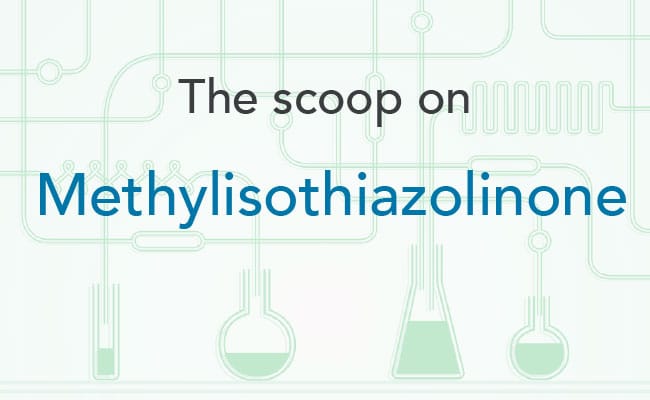
What is methylisothiazolinone?
Methylisothiazolinone (MIT) is a preservative that is found in a wide array of liquid cosmetics, personal care products and cleaning products on the market today. Its function is to inhibit the growth of bacteria.
What products is methylisothiazolinone in?
Methylisothiazolinone is found in a multitude of products, including those claiming to be “natural”. The list includes cleaning products, detergents, lotions, sunscreens, shampoos, conditioners, hair coloring, body washes, mascara, shaving cream, make-up remover, liquid soaps, and baby products including wipes, lotions and shampoos.
How to tell if a product has methylisothiazolinone
Methylisothiazolinone may be listed as other names on product labels including:
Methylisothiazolinone
3(2H)-Isothiazolone, 2-methyl-
2-Methyl-2H-isothiazol-3-one
2-Methyl-4-isothiazolin-3-one
2-Methyl-3(2H)-isothiazolone
Risks associated with methylisothiazolinone
MIT has been linked to allergic reactions, lung toxicity, and neurotoxicity. The European SCCS has declared that there is no safe concentration of MIT in leave-on products. In Canada, it has been banned from use in cosmetics. Health issues commonly linked to MIT include: skin reactions (it is a contact allergen), skin sensitization, painful rashes, inhalation toxicity, organ toxicity, neurotoxicity (based on lab studies on the brand cells of mammals).
How to avoid methylisothiazolinone
A key thing to know is that methylisothiazolinone is very common in products claiming to be “natural”, so start by always looking at ingredient labels. Be sure to avoid products that contain MIT and any of the other synonyms like MICROCARE MT or NEOLONE 950 PRESERVATIVE. If you or a family member has sensitive skin, you should especially avoid products that contain both CMIT and MIT. For babies and young children, be aware that methylisothiazolinone may be in baby soaps, shampoos and even baby wipes that have been labeled “hypoallergenic” or “natural”. That’s because there are no government standards stipulating criteria for hypoallergenic or “natural” products.
In cleaning products, where manufacturers aren’t required to list all their ingredients on product labels, choose toxic chemical free alternatives that don’t contain MIT. Also remember that because there are no federal criteria dictating standards for what makes a cleaning product “natural”, a multitude of so-called natural cleaners contain this toxic chemical. Instead, go with options using simple, toxic-free ingredients. A good option is Force of Nature, which is a multipurpose cleaner and disinfectant that kills 99.9% of germs without any harmful residues or fumes. It contains no preservatives, fragrances, dyes or surfactants and is certified 100% skin-safe and best for sensitive skin by SkinSAFE, Mayo Clinic’s allergy rating system.
In personal care products, do your own research on a product’s ingredients by using a resource such as the Environmental Working Group’s Skin Deep product database.



